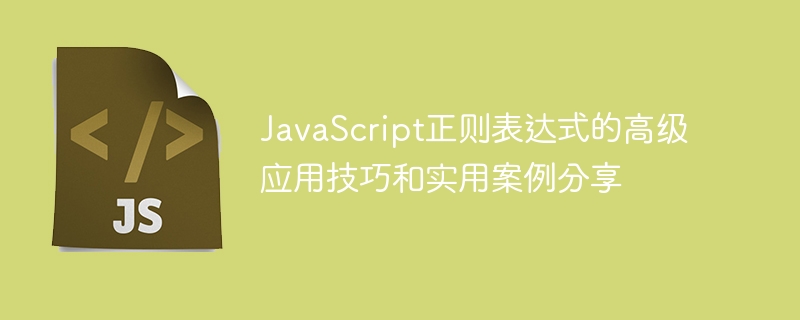分享实用案例和高级技巧:JavaScript正则表达式的进阶应用
- WBOY原创
- 2024-01-05 20:20:481131浏览

分享实用案例和高级技巧:JavaScript正则表达式的进阶应用
导言:
正则表达式是一种强大的文本处理工具,广泛应用于各种编程语言中。在JavaScript中,正则表达式同样具有重要的地位,并且在日常开发中被广泛使用。本文将详细介绍JavaScript正则表达式的高级应用技巧,并分享一些实用案例,帮助读者更好地掌握该技术并应用于实际开发中。
一、基本概念回顾:
在深入学习JavaScript正则表达式之前,我们应该先回顾一下正则表达式的基本概念。正则表达式是一种用于匹配、查找和替换字符串的模式。它由各种字符和元字符组成,可以使用这些字符和元字符来描述一个文本模式。在JavaScript中,我们可以使用RegExp对象来创建并操作正则表达式。
二、高级应用技巧:
- 正则表达式的修饰符:
在JavaScript正则表达式中,修饰符是对正则表达式进行修饰或配置的选项。常见的修饰符包括i、g、m和s等,分别表示忽略大小写、全局匹配、多行匹配和点匹配任何字符(包括换行符)等。
示例:
// 忽略大小写匹配
let regex = /hello/i;
console.log(regex.test("Hello")); // true
// 全局匹配
let regex2 = /hello/g;
console.log("hello world".replace(regex2, "hi")); // hi world
// 多行匹配
let regex3 = /^hello/m;
console.log(regex3.test("hello
world")); // true
// 匹配换行符
let regex4 = /hello.world/s;
console.log(regex4.test("hello
world")); // true- 匹配界定符和边界:
在正则表达式中,界定符用于匹配一组括起来的字符,常见的界定符包括方括号([])、圆括号(())和花括号({})。而边界则是用于限定字符串的开头或结尾的位置。
示例:
// 匹配数字
let regex = /[0-9]/;
console.log(regex.test("123")); // true
// 匹配括号内的内容
let regex2 = /((.*?))/;
let match = "Hello (world)".match(regex2);
console.log(match[1]); // world
// 匹配单词边界
let regex3 = /hello/;
console.log(regex3.test("say hello")); // true- 非捕获分组:
在正则表达式中,使用捕获分组可以将匹配到的结果保存起来以便后续使用。然而,在某些情况下,我们可能只需要匹配但不需要保留结果,这时可以使用非捕获分组。
示例:
// 捕获分组 let regex = /(d+)s+s(d+)s=/; let match = "1 + 2 =".match(regex); console.log(match[1]); // 1 console.log(match[2]); // 2 // 非捕获分组 let regex2 = /(?:d+)s+s(?:d+)s=/; let match2 = "1 + 2 =".match(regex2); console.log(match2); // null
- 前后查找:
正则表达式中的前后查找可以根据某些条件来匹配字符串的前后内容。前查找使用正向肯定界定符(?=)和正向否定界定符(?!),后查找使用反向肯定界定符(?
示例:
// 前查找
let regex = /hello(?= world)/;
console.log(regex.test("hello")); // false
console.log(regex.test("hello world")); // true
// 后查找
let regex2 = /(?<=hello) world/;
console.log(regex2.test("world")); // false
console.log(regex2.test("hello world")); // true三、实用案例分享:
- 邮箱验证:
使用正则表达式可以方便地进行邮箱格式验证,确保用户输入的邮箱格式正确。
示例:
function validateEmail(email) {
let regex = /w+@w+.w+/;
return regex.test(email);
}
console.log(validateEmail("example@mail.com")); // true
console.log(validateEmail("invalid.email")); // false- URL提取:
通过正则表达式的匹配和捕获分组,可以方便地从一段文本中提取出所有的URL链接。
示例:
function extractUrls(text) {
let regex = /https?://[^s]+/g;
return text.match(regex);
}
let text = "Visit my website at https://example.com or https://google.com";
console.log(extractUrls(text)); // ["https://example.com", "https://google.com"]- 敏感词过滤:
正则表达式可以用来实现敏感词过滤,将敏感词替换为其他字符或直接删除。
示例:
function filterSensitiveWords(text, wordList) {
let regex = new RegExp(wordList.join('|'), 'gi');
return text.replace(regex, '***');
}
let text = "This is a sensitive word: bad";
let wordList = ["bad"];
console.log(filterSensitiveWords(text, wordList)); // "This is a sensitive word: ***"总结:
本文介绍了JavaScript正则表达式的高级应用技巧,并分享了一些实用的案例。通过学习这些技巧和示例,读者可以更好地应用正则表达式来处理文本内容,并在实际开发中发挥强大的功能。然而,正则表达式仍然是一项复杂的技术,读者在使用中应注意语法的正确性和性能的考虑。
以上是分享实用案例和高级技巧:JavaScript正则表达式的进阶应用的详细内容。更多信息请关注PHP中文网其他相关文章!
声明:
本文内容由网友自发贡献,版权归原作者所有,本站不承担相应法律责任。如您发现有涉嫌抄袭侵权的内容,请联系admin@php.cn

